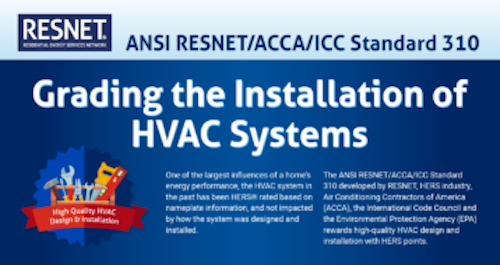The Home Energy Rating System (HERS) was established in the 1990s by the energy-efficiency non-profit RESNET to help builders create energy-efficient homes.
In essence, the lower your HERS score, the less power is required to power your home.
Today, the HERS standard has become a popular tool for governments to determine whether builders are eligible for different tax credits and rebates and if they meet certain municipal code requirements.
While many best practices were built to help conform to new energy standards and lower HERS ratings, there were surprisingly few standards and best practices around HVAC equipment.
Recent efforts by RESNET and Air Conditioning Contractors of America have sought to bridge this oversight by introducing Standard 310 into common RESNET and ACCA best practices.
Standard 310 Overview
Official Name: ANSI/RESNET/ACCA Standard 310-2020 “Standard for Grading the Installation of HVAC Systems”
Standard 310 provides grading standards for forced-air cooling and heat pump systems. The standard relies on five main tasks designed to reduce the HERS rating of homes where new HVAC systems are installed using non- or minimally invasive measures.
Implementing this standard is completely voluntary, but it benefits businesses, including a pathway toward reaching the 45L tax credit. Based on previous data, Standard 310 has been shown to lower the average home’s HERS rating by 5 points when following full standard recommendations.
Implementing RESNET/ACCA 310: 5 Key Steps
The five main tasks of Standard 310 are designed to be followed sequentially and include two prerequisite tasks for installation.
- HVAC System Design Review: Installers must ensure that all builds meet tolerances outlined under the grading protocols of Standard 310. For a full list of tolerances, scroll down to Section 4.2 of this PDF.
- Total Duct Leakage Testing: Duct leakage is measured using Standard 380 protocols and graded on a level of I-III. Grade I or II duct leakage results will pass inspection.
- Blower Fan Volumetric Test: Similar to a blower door test, a blower fan test measures the total volumetric airflow to meet pre-established tolerances under Standard 310. Airflow can be measured using a flow grid, pressure matching, flow hood, or static table.
- Blower Fan Watt Draw Test: The total electricity meant to power a blower fan is measured by a watt meter to determine the system’s efficiency. ACCA 5 QI does not have a universal standard, nor is one required to pass this requirement.
- Refrigerant Charge Evaluation: Evaluators measure the temperature of refrigerant lines inside or outside the house to determine the charge. The weigh-in method is also acceptable for measuring the charge.
Tasks 1-3 require specific thresholds to be met to advance to tasks 4-5, which provide a broader view of how much electricity your HVAC unit consumes.
How New HVAC Efficiency Standards Benefit Builders
Since Standard 310 is completely voluntary, implementing its protocols comes at no cost to builders and contractors and can benefit them in several ways:
- 45L Tax Credit: Reaching a lower HERS rating by following Standard 310 protocols increases your likelihood of qualifying for the $2,000 45L tax credit for energy efficiency.
- Increased Home Value: Improving the energy efficiency of new builds increases the underlying value of the house, allowing you to charge a higher sticker price for sale. Builders can follow Standard 310 for forced-cooling systems or invest in the Rheia system.
- Improved Customer Satisfaction: Lower utility bills lead to happier customers, which increases your reputation and word-of-mouth advertising around town.
Obstacles to Implementing Standard 310
New RESNET/ACCA standards are highly specialized and reserved for specific HVAC units. As a result, it’s become increasingly difficult for builders and contractors to keep up with new standards, even if they are entirely voluntary.
Currently, only certain accredited software is accepted to tally HVAC grades using Standard 310 protocols, which most builders don’t have access to. Furthermore, raters and inspectors must be certified in Standard 310 protocols to grade any HVAC system accurately.
Tips to Implement Standard 310 at Your Firm
Adopting RESNET/ACCA Standard 310 requires a strategic approach to ensure effective implementation:
- Leadership Buy-In: Securing support from top leadership is crucial. Leadership buy-in fosters a culture of commitment to energy efficiency, motivating employees at all levels to embrace the standard’s principles.
- Collaborative Training: Training workers on new standards makes you more likely to meet the required thresholds. It also doesn’t hurt to have someone on your team certified in Standard 310 for rating and grading.
- Comprehensive Assessment: Conduct a comprehensive energy assessment of the building to ensure it meets Standard 310 thresholds.
- Leverage Energy Modeling: Utilize energy modeling software to simulate the energy performance of a building. This helps you predict how changes and improvements will impact energy consumption during installation.
Implementing Standard 310 requires some training and education.
Informing staff on new changes to RESNET/ACCA standards will make it more likely that they abide by those standards and are eligible for special tax credits and rebates that improve your bottom line.
FAQs: Standard 310
What Is Standard 310?
Standard 310 was developed in partnership between RESNET and ACCA to provide specific tasks that improve the energy efficiency of homes with brand-new HVAC units.
What HVAC Units Does Standard 310 Apply to?
Standard 310 applies to forced-air cooling and heat pumps.
Is Standard 310 Required By Law?
No. Standard 310 is entirely voluntary.


